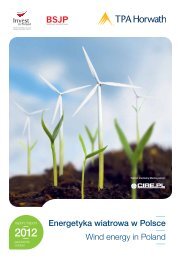Energetyka wiatrowa w Polsce Wind energy in Poland - TPA Horwath
Energetyka wiatrowa w Polsce Wind energy in Poland - TPA Horwath
Energetyka wiatrowa w Polsce Wind energy in Poland - TPA Horwath
Create successful ePaper yourself
Turn your PDF publications into a flip-book with our unique Google optimized e-Paper software.
20<br />
w umowie dzierżawy zamieścić dodatkowe zapisy<br />
dające dzierżawcy prawo do pobierania pożytków.<br />
Przykładem może być umowne zagwarantowanie<br />
prawa do poddzierżawiania nieruchomości, będące<br />
prawem uzyskiwania pożytków cywilnych z gruntu.<br />
W celu uniknięcia ryzyka wypowiedzenia stosunku<br />
dzierżawy przez nabywcę dzierżawionej nieruchomość,<br />
należy zawrzeć umowę w formie pisemnej<br />
z datą pewną. Ponadto dzierżawiona nieruchomość<br />
pow<strong>in</strong>na zostać wydana <strong>in</strong>westorowi, co należy<br />
stwierdzić pisemnym protokołem. Ważne jest też, aby<br />
już w chwili zawarcia umowy przedmiot dzierżawy<br />
był dokładnie określony. W przeciwnym przypadku<br />
umowa dzierżawy może zostać uznana za nieważną.<br />
Podjęcie powyższych środków nie wyłącza jednak<br />
ryzyka wypowiedzenia umowy dzierżawy przez<br />
nabywcę nieruchomości w drodze postępowania<br />
egzekucyjnego albo upadłościowego. Zgodnie ze<br />
znowelizowanym art. 1002 kodeksu postępowania<br />
cywilnego 7 , nabywca egzekucyjny może rozwiązać<br />
z zachowaniem rocznego term<strong>in</strong>u wypowiedzieć<br />
umowę dzierżawy zawartą na okres co najmniej 2 lat,<br />
chociażby została ona podpisana z zachowaniem<br />
formy pisemnej i z datą pewną, a nieruchomość<br />
została dzierżawcy wydana. Dlatego wskazane jest<br />
zamieszczenie w umowie postanowień m<strong>in</strong>imalizujących<br />
ryzyko wszczęcia egzekucji przeciwko właścicielowi<br />
nieruchomości. Takim postanowieniem będzie<br />
przykładowo zakaz obciążania nieruchomości hipotekami,<br />
możliwość zapłaty czynszu do rąk wierzyciela<br />
właściciela nieruchomości, czy też prawo pierwokupu.<br />
Leas<strong>in</strong>g<br />
Ryzyka związane z zawarciem umowy dzierżawy<br />
skłaniają do poszukiwania <strong>in</strong>nych sposobów zabezpieczenia<br />
praw do gruntu pod turb<strong>in</strong>y wiatrowe. Jedną<br />
z możliwości jest zawarcie umowy leas<strong>in</strong>gu bezpośredniego.<br />
Obecnie nie jest to jednak rozpowszechniona<br />
forma zabezpieczenia praw do nieruchomości<br />
pod turb<strong>in</strong>y wiatrowe.<br />
Leas<strong>in</strong>g zapewnia prawo do korzystania lub korzystania<br />
i pobierania pożytków z rzeczy, odpada więc<br />
problem zapewnienia w umowie prawa do czerpania<br />
pożytków z farmy wiatrowej. Przy leas<strong>in</strong>gu<br />
nieruchomości powstaje jednak problem kalkulacji<br />
wynagrodzenia właścicieli za korzystanie, które musi<br />
odpowiadać wartości nieruchomości. Pozostaje<br />
poczekać, czy ta forma zabezpieczenia praw zostanie<br />
w <strong>Polsce</strong> rozpowszechniona.<br />
Użytkowanie<br />
Oprócz zabezpieczenia praw do gruntu w formie<br />
umowy dzierżawy czy leas<strong>in</strong>gu, możliwe jest<br />
również zawarcie umowy użytkowania. Użytkowanie<br />
to ograniczone prawo rzeczowe, które daje<br />
7 Ustawa z 16 września 2011 roku o zmianie ustawy – Kodeks<br />
postępowania cywilnego oraz niektórych <strong>in</strong>nych ustaw ( Dz. U. 2011,<br />
Nr 233 poz. 1381)<br />
<strong>Energetyka</strong> <strong>wiatrowa</strong> w <strong>Polsce</strong> / <strong>W<strong>in</strong>d</strong> <strong>energy</strong> <strong>in</strong> <strong>Poland</strong><br />
a right to derive benefits. For example, the agreement<br />
may warrant the right to sublease the property which<br />
constitutes a right to derive civil benefits from the land.<br />
To avoid the risk that the buyer of the leased property<br />
will term<strong>in</strong>ate the lease, the agreement should be<br />
executed <strong>in</strong> writ<strong>in</strong>g with a date certa<strong>in</strong>. Moreover, the<br />
leased property should be released to the <strong>in</strong>vestor,<br />
and the release should be confirmed by a written<br />
report. It’s also crucial to specifically def<strong>in</strong>e the<br />
subject of lease upon conclusion of the agreement.<br />
Otherwise, the lease agreement may be considered<br />
<strong>in</strong>valid. However, tak<strong>in</strong>g the aforementioned<br />
precautions will not elim<strong>in</strong>ate the risk that the lease<br />
agreement may be term<strong>in</strong>ated by the buyer of the<br />
leased property dur<strong>in</strong>g the course of enforcement or<br />
bankruptcy proceed<strong>in</strong>gs. In l<strong>in</strong>e with the amended<br />
Article 1002 of the Civil Procedure Code 7 , the<br />
assignee <strong>in</strong> enforcement proceed<strong>in</strong>gs may term<strong>in</strong>ate<br />
a lease agreement entered <strong>in</strong>to for a term of not less<br />
than 2 years, upon a one-year term<strong>in</strong>ation notice,<br />
even if such agreement had been executed <strong>in</strong> writ<strong>in</strong>g<br />
and with a date certa<strong>in</strong>, and the property had been<br />
released to the lessee. Therefore, it is advisable that<br />
the agreement conta<strong>in</strong>s provisions mitigat<strong>in</strong>g the risk<br />
of enforcement <strong>in</strong>stigated aga<strong>in</strong>st the property owner.<br />
Such provisions would <strong>in</strong>clude, without limitation,<br />
a ban on establish<strong>in</strong>g mortgages on the property,<br />
an option to pay lease rent to the property owner’s<br />
creditor or the first refusal right.<br />
Leas<strong>in</strong>g<br />
The risks associated with the lease agreement prompt<br />
<strong>in</strong>vestors to search for other methods of secur<strong>in</strong>g<br />
titles to the land designated for w<strong>in</strong>d turb<strong>in</strong>es. One<br />
of the alternatives comes <strong>in</strong> the form of direct leas<strong>in</strong>g<br />
agreements. At the moment, however, this form of<br />
secur<strong>in</strong>g a property title for w<strong>in</strong>d turb<strong>in</strong>es is not very<br />
common.<br />
Leas<strong>in</strong>g ensures the right to use the object of leas<strong>in</strong>g<br />
and derive benefits from it, which automatically<br />
elim<strong>in</strong>ates the problem of secur<strong>in</strong>g the right to derive<br />
benefits from a w<strong>in</strong>d farm <strong>in</strong> the agreement. However,<br />
property leas<strong>in</strong>g poses an issue of calculat<strong>in</strong>g the<br />
owner’s remuneration for bus<strong>in</strong>ess use, which needs<br />
to correspond to the value of the property. It seems<br />
worthwhile to wait and see if that method of secur<strong>in</strong>g<br />
property rights becomes more common <strong>in</strong> <strong>Poland</strong>.<br />
Bus<strong>in</strong>ess Use<br />
Alternatively to secur<strong>in</strong>g the title to the land through<br />
lease or leas<strong>in</strong>g, an <strong>in</strong>vestor can enter <strong>in</strong>to a bus<strong>in</strong>ess<br />
use agreement. Bus<strong>in</strong>ess use is a limited property<br />
right whereby the user is granted the right to use the<br />
subject of bus<strong>in</strong>ess use and derive benefits from<br />
7 Legal Act of 16 September 2011 amend<strong>in</strong>g the Civil Procedure Code<br />
and certa<strong>in</strong> other legal acts (Journal of Laws of 2011, No. 233 Item<br />
1381)



